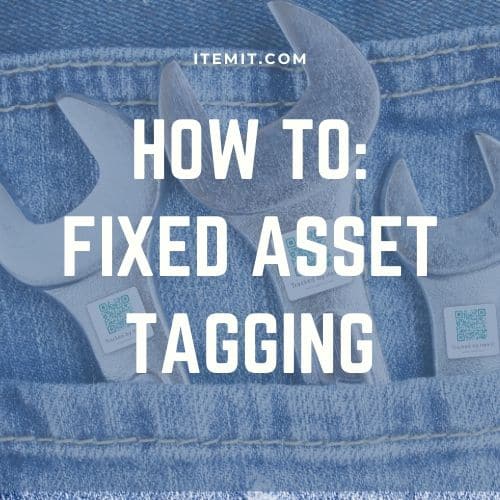
Fixed asset tracking is essential to ensure your business is running as smoothly and effectively as possible. With fixed asset tracking, you’ll be able to monitor your costs and operations better to save time and money.
Fixed asset tagging allows you to streamline and optimise, and is essential to increase your visibility over assets and ease-of-use when it comes to managing fixed assets.
With fixed asset tagging, you’ll be able to do many more things, including edit asset information faster and manage your fixed asset inventory with ease.
Types of Fixed Asset Tags
The types of fixed asset tags you’ll use will depend on your needs. For example, with construction equipment tracking, you may want to consider using a solution which integrates GPS tracking. With GPS tracking, you’ll be able to monitor asset location in real-time.
Generally, you’ll build your fixed asset tracking processes up by starting off with QR code asset tags or barcodes. These will open up many of the helpful features fixed asset tracking software can provide.
You’ll be able to customise your QR codes and barcodes. So, it’ll be possible to use metal QR tags or sticker tags, depending on how much wear and tear the tools and equipment you’re tracking goes through.
Which are better, QR codes or Barcodes? Find out in our QR Codes Vs. Barcodes blog.
How To Implement Fixed Asset Tagging
There is a simple step by step process behind implementing your fixed asset tagging processes. Your goal will be to save time and money by increasing asset visibility and reducing asset retrieval times, as well as improve other processes fixed asset management can help with.
1. Create Your Fixed Asset Register
The first step is to audit your assets and create a fixed asset register. If you’re familiar with spreadsheets, you’ll be familiar with the limitations spreadsheets have.
However, if you have a spreadsheet of a fixed asset inventory, you’ll be able to use this in the first step towards better, more automated fixed asset tracking.
Knowing what you own will help inform your fixed asset management decisions, but it’s still essential at this stage your inventory is as up to date as possible. This way, you’ll avoid dreaded ghost assets and zombie assets.
2. Choose Your Asset Tags
When you have a register of your fixed assets, it’ll help steer the next steps of your decision.
Choosing your asset tags is a lot simpler when you can see which fixed assets require rugged labels and which only need sticker tags.
If you want to purchase QR code asset tags, you can look through our options below. We also do custom labels, such as tiny QRs and iron-on tags, so don’t hesitate to ask!
3. Choose Your Fixed Asset Tracking Software
Knowing which tags you need and which assets you own will help you decide what you’ll need your fixed asset management software to do. For example, if you can see that your fixed asset register is largely made up of laptops, you’ll want to opt for a software that has a lot of IT asset management features.
When you’re choosing a fixed asset tracking software, you’ll be able to start a free trial to ensure that the software does everything you need it to.
If you want a demo, you’ll be able to book one using the button below.
This way, you’ll have absolute clarity that your fixed asset management software has time-saving and cost-saving features.
As you’ll already have the tags, you’ll be able to start testing straight away and ensure you’re making the right decision. You’ll be able to implement fixed asset tagging on a few of your assets to test before you scale your solution.
4. Expand it to your entire business
Once you’ve trialled, purchased, and started to use your fixed asset management software, the next step is to expand asset tracking to your entire business.
This involves implementing your fixed asset tagging processes across your business, tagging all of the assets you have on your register.
It’s possible to import your fixed asset register into your fixed asset management software, including fixed asset tag information, so that once you’re scaling, all you need to do is start tracking.
All you need to do is contact us. We’ll be happy to help you get up and running as soon as possible. Drop us an email at team@itemit.com or fill in the form below to start tracking your fixed assets.
Or, you can check out these blogs:
Tool Tracking Tips: Optimise your operations with a construction tool tracking app
Why you Need Computer Asset Tracking Software
The Best Practices for Using an IT Asset Register
Start Your Fixed Asset Tagging Process Today!

Try itemit
Choose a better way to track
your assets.
Start your free 14-day trial now!

Keep Learning
itemit Blog
Tips, guides, industry best practices, and news.
Track Your Agricultural Assets With RFID Tags
Discover how RFID technology enhances agriculture management with better inventory tracking, livestock monitoring, and operational efficiency, even for small farms.
Which Is Better? RFID Tags Or Barcodes?
Is RFID asset tracking better than using barcodes or is it vice versa? Read this post now to discover which option is ideal for you!
The Future Of Asset Tracking Involves RFID Tags: Here’s Why
Find out exactly why the future of asset tracking in the workplace involves RFID asset tracking by reading this article now!


